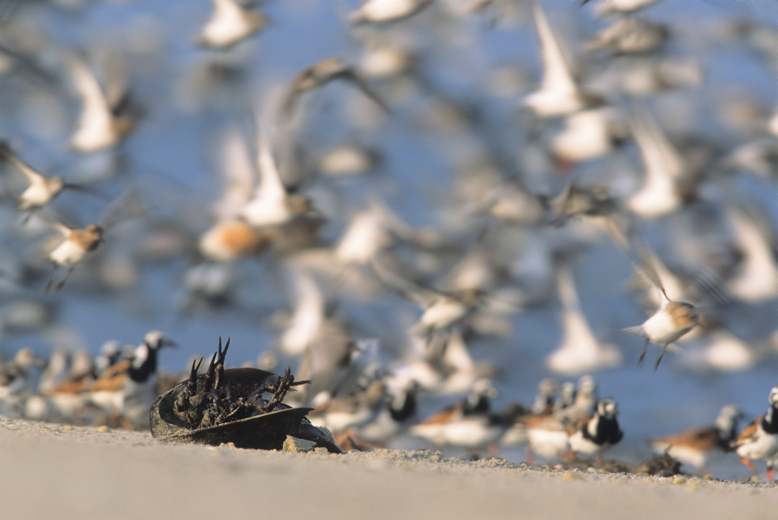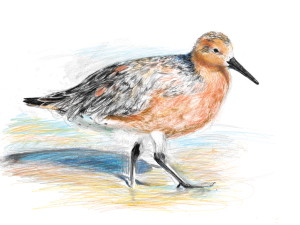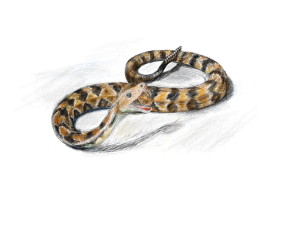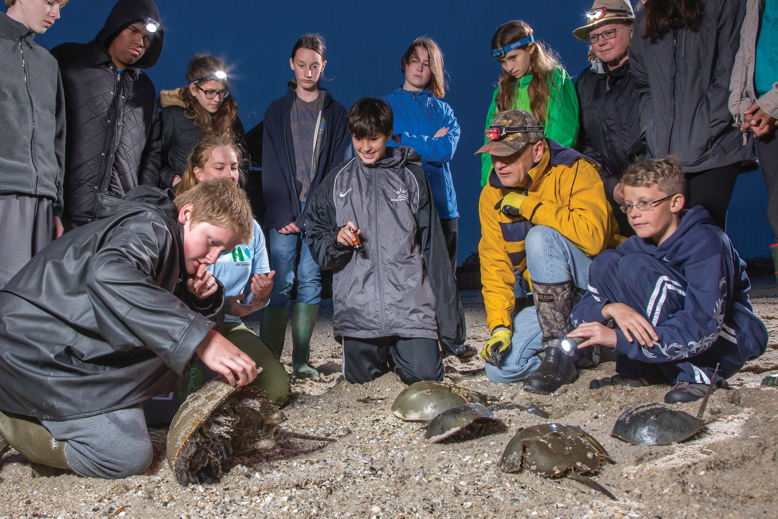
Horseshoe crabs—a key component of the Delaware Bay ecosystem and essential for the survival of dozens of species—are easily beached on land. Photo credit: Steve Greer.
Pity the poor horseshoe crabs. Despite 450 million years of evolution, the marine arthropods have never developed a foolproof way to flip themselves over when they’ve been turned upside down on a sandy beach. That leaves them vulnerable to sun exposure and birds of prey.
To assist the prehistoric creatures, who enter New Jersey bay beaches to mate and lay their eggs each spring, the Wetlands Institute helped launch reTURN the Favor. In late April, Lisa Ferguson, director of research and conservation with the Stone Harbor-based nonprofit, carefully explained to a group of first-time volunteers the proper technique for turning the crabs right side up.
Throughout the spring and early summer, the volunteers and dozens of others probed miles of sand along the Delaware Bay to aid the crabs, ensuring that as many as possible survived to spawn millions of eggs.
The crabs are not the only beneficiaries of the program. Their eggs support dozens of species and are essential for the survival of one in particular: the rufa red knot, one of more than 80 species listed as endangered or threatened in New Jersey.

Rufa red knot. Illustration by Janice Belove
The rufa red knot, a medium-sized shorebird, embarks each year on one of nature’s longest migrations. For some of the birds, the annual journey stretches an astounding 18,000-mile round-trip between their breeding grounds in the Canadian Arctic to their wintering quarters in Tierra del Fuego, at the southernmost tip of South America.
When the birds head north, they follow a path along the Atlantic Flyway, with a crucial stop on the Delaware Bay, halfway to their destination. Some of the birds will have flown nonstop for six days to feed on the bay’s fat-rich horseshoe crab eggs.
The knots arrive at the bay weighing about 120 grams (just over 4 ounces). “They come completely depleted,” says Stephanie Feigin, a biologist with the Conserve Wildlife Foundation of New Jersey (CWF). “They actually start digesting their own intestinal tract.”
Some birds rest for two days before they can even begin eating. Once they start feasting on crab eggs, they refuel in a frenzy for about two weeks. They must store enough fat to reach their average normal weight of 180 grams (about 6 ounces) before taking off—thousands at once—for the Arctic.
In a ritual of nature that has taken place for more than 10,000 years, the spawning of horseshoe crab eggs in early May is soon followed by the arrival of the knots. The dance in the bay had unfolded in perfect balance for centuries. Then, in the 1990s, the red knot population began to plummet. The number visiting the Delaware Bay decreased from 90,000 in 1980 to about 50,000 in 1998. The following year, the rufa red knot was added to the state’s threatened-species list. Yet the threat continued. By 2007, the rufa red knot reached a nadir of 13,000.

Timber rattlesnake. Illustration by Janice Belove.
Biologists scrambled to explain the decline. It wasn’t long before they realized the crisis was tied to the overharvesting of horseshoe crabs. Beginning more than a century ago, crabs had been taken by the millions to be ground up and used as fertilizer. That use slowed, but was replaced by another threat in the mid-20th century, when the eel-and conch-fishing industries began using the crabs as bait.
Then in the 1970s, the discovery of the compound limulus amebocyte lysate (LAL) in crab blood, led to harvesting by the biomedical industry, which markets the compound to test injectable drugs and implantable medical devices for biological contamination. Over the past four decades, the bleeding of crabs for LAL has become a multimillion dollar industry; hundreds of thousands of crabs continue to be captured each year on the Atlantic shores as raw material.
After conservationists fought for half a decade, a moratorium was placed on crab harvesting in 2008, limiting the number that can be taken from the bay. Currently, no crabs can be harvested for bait in New Jersey, but an unspecified number can still be taken for biomedical use. (About 500,000 crabs were harvested at biomedical facilities from Maine to Florida in 2014, according to the Atlantic States Marine Fisheries Commission.)
READ MORE: Tips on how to get involved to support New Jersey’s imperiled species.
Despite the moratorium, red knot numbers remained low and the species was recategorized from threatened to endangered in 2012. Such designations are determined on a state level by the New Jersey Division of Fish and Wildlife Endangered and Nongame Species Program (ENSP), and on a federal level by the U.S. Fish and Wildlife Service or the National Marine Fisheries Service.
Horseshoe crabs are not currently listed, but some reports estimate the Delaware Bay population, while still numbering in the millions, has declined; one study shows a 90 percent decline from 1990 to 2005. That’s why it’s so important for scientists and volunteers to do everything they can to help both species until they begin to rebound—even if it entails something as unscientific as walking the beach in search of overturned crabs.

Volunteers with reTURN the Favor visit one of 19 Delaware Bay beaches in New Jersey, where they help stranded horseshoe crabs by flipping them right side up. Photo credit: Steve Greer.
The efforts have helped stabilize the red knot population, but the birds are still at only 26 percent of their historic numbers. The overharvesting of crabs is not their only problem, says ENSP chief Dave Jenkins. Threats to the bird include habitat loss due to sea level rise; coastal development; shoreline obstructions like seawalls and jetties; intensified competition with other species for food; disturbances by vehicles, people, dogs, aircraft and boats; and climate change.
The red knot is a prime example of what an endangered species looks like. According to the ENSP website, an endangered species is one “whose prospects for survival in New Jersey are in immediate danger due to various threats.” Assistance is needed to help prevent extinction.
Threatened species are those that may become endangered if conditions affecting them begin or continue to deteriorate. A third designation—species of special concern, which includes over 100 additional species—indicates populations that warrant special attention because of conditions that may result in their becoming threatened.
